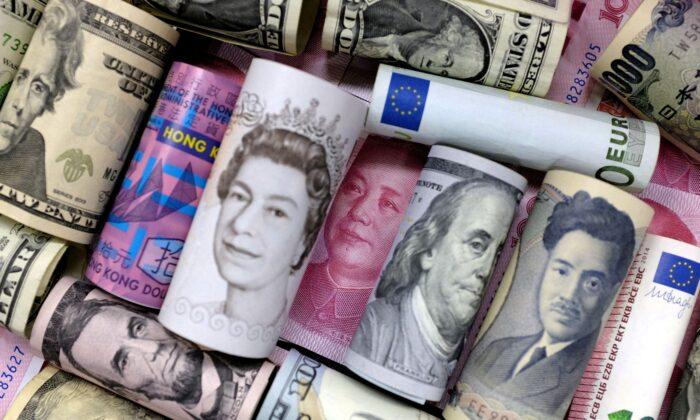LONDON/SINGAPORE—The dollar rose on Thursday as investors digested mixed U.S. economic data, while the British pound changed direction and slipped ahead of the government’s budget update.
The greenback has tumbled in recent weeks as inflation data and comments from Federal Reserve officials have suggested that the central bank can soon slow the pace of its punishing interest rate hikes.
Yet the dollar rose on Thursday after U.S. retail sales data for October, released on Wednesday, came in stronger than expected.
The euro was down 0.33 percent against the dollar at $1.036 at 1045 GMT, after hitting its highest level since July at $1.048 on Tuesday.
The dollar index, which measures the currency against six major peers, rose 0.32 percent to 106.62. The index has fallen more than 6 percent since hitting a 20-year high in September, although it remained 11 percent higher for the year on Thursday.
“Markets have positioned for the Fed to pivot (but) the U.S. retail sales data very much challenges that narrative,” said Commonwealth Bank of Australia currency strategist Kim Mundy.
Simon Harvey, senior FX analyst at Monex Europe, said the dollar was consolidating as investors try to work out the direction of the U.S. economy.
“The positive consumption data suggests we don’t have a hard landing coming (for the economy). But is that positive for risk assets or will it embolden the Fed to go harder?” he said.
Harvey said the biggest price action could be in the British pound when finance minister Jeremy Hunt announces the government’s budget plans later on Thursday. He is expected to raise taxes and cut spending, despite a looming recession, in an effort to bolster Britain’s reputation with markets and cool inflation.
Sterling was down 0.35 percent against the dollar to $1.187, after rising earlier in the session. It was roughly flat against the euro.
Traders will also scrutinize speeches from numerous Fed officials on Thursday for hints about rate hikes. Regional Fed Presidents Raphael Bostic, Loretta Mester, and Neel Kashkari are all due to speak.
Hawkish remarks from Fed officials overnight added to doubts about a shift in policy, with San Francisco Fed President Mary Daly—until recently one of the most dovish officials—saying a pause was off the table.
The greenback rose 0.15 percent against the Japanese yen on Thursday to 139.75 after falling earlier in the session. It plunged 3.7 percent on Thursday last week when U.S. consumer inflation data for October came in lower than expected.
China’s yuan fell 0.75 percent to 7.154 per dollar as new COVID-19 cases caused concerns that authorities could order more lockdowns.
The Aussie dollar dropped 0.87 percent lower at $0.668, while the Kiwi fell 0.63 percent to $0.611.





